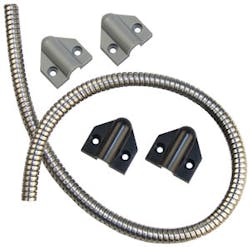On many door control systems, it's necessary to make electrical connections to devices on the moving door. One example would be an exit bar-type device mounted on the door which signals the access control system to release an electromagnetic lock or shunt out the alarm system. The most basic way to achieve this is with a door loop or cord.
Securitron's TSB-C surface-mounted door cord provides one of the simplest and economical solutions for power transfer.
The TSB-C is furnished with Securitron's Touch Sense Bar but may also be purchased separately. The cord consists of an 18" (46 cm) length of armored stainless steel cable with plastic end pieces. 3/8" (9.5 mm) holes are drilled in the face of the door and frame to admit the cord and the end pieces are screwed down over the holes to create a neat, finished appearance. The door cord comes furnished with end pieces set in two colors: light gray and black. This allows selection of end pieces color so as to blend into the door/frame color as much as possible.
The ample 18" cord length allows use of any type of door, including center pivot doors and doors that open well past 90 degrees The TSB-C cable has an interior diameter of .25" (6mm) which will support interior wire cables up to .2" (5mm) thick. This permits employing thick enough wiring for most high current applications.
These cords work well for many applications. However, they are sometimes unsatisfactory because door cords are highly visible, and therefore may become targets for vandals. So for aesthetics and endurance, alternative methods transferring power are sometimes required.
Wired hinges and power transfers are the two most frequently used devices. Power transfers come in two basic flavors: surface-mounted and concealed.
Securitech's TransX™ provides a method to bring those wires invisibly from the door to the frame. The wires are concealed within modules applied to the door and frame and travel within a steel channel between the modules.
TransX is designed for installation on doors with standard full mortise hinges. Long lead wires from the control trim and or lock body, eliminating wire connections within the door. Pull the long leads through the TransX door module into the frame module and make connections there.
As a result, locksmiths can troubleshoot the connectors at the frame module. Remove the frame module cover and test connections.
The frame module cover has a lip which extends under the header. This prevents removal of the cover or access to the terminal strip while the door is closed. Tamper switches are available.
TransX transfers multiple wires from the door to the frame in a concealed, protected manner. Lock installers bring their wires through the door into the TransX door module. They snake the wire through to the frame module and make their connections on the bottom side of the terminal strip.
ELECTRIC DOOR STRIKE SECURITY
Although the use of positive latching electric locking devices should provide secure mechanical locking, sometimes they do not. Here are some important details to remember when specifying, installing and testing electric strikes.
Surface-mounted strikes ARE designed for use with rim latches, such as exit devices.
Flexing of the frame: Under certain conditions, a door frame may twist allowing the latch to ramp, thereby allowing the door to open. This condition has been observed on both steel and aluminum door frames. It is increased if there is inadequate latch strike engagement. Latch spring tension is another variable in this equation, but latch spring tension is not usually the problem. Reinforcing the door frame and using stronger fasteners are two good ways to prevent/correct unlocking issues. The problem is due to the change in the latch/strike engagement caused by a twisting door frame.
Inadequate latch engagement is another major (but preventable) factor in electric locking device failure. Professional electric locking devices all specify the size of latch they are designed to be used with. For example, .75 is a common latch length. The amount of latch engagement you achieve will be governed by the latch size, the capacity of the electric lock, the size of the gap between the door and the frame, and the way the strike is mounted in the frame. Adequate latch engagement is at least 66 percent. That is, if your latch is .75 then you should have .5 of it behind the strike in order to assure good locking.
Improper deadlatch trigger adjustment: On door strikes which are 'cut' into the frame; the geometry of the strike and frame makes frame flexing less an issue. Latch engagement is nonetheless critical. For those latch locks which use a deadlatch trigger, proper alignment and depression of the trigger is necessary to achieve an acceptable level of security. On some types of locks, the deadlatch is located on the flat side of the latch, and if it falls behind the strike, you are losing the deadlatch feature. On other types of locks, such as mortise types, the deadlatch trigger is adjacent to the latch. If the trigger is not depressed adequately, if the trigger falls in behind the strike keeper, or if the deadlatch trigger is out of adjustment inside the lock itself; the lock is not going to provide the security it was designed to provide, and the device may exhibit some mysterious symptoms.
For those styles of electric locks where the deadlatch trigger is next to the latch, misalignment between the latch and the strike, and not depressing the deadlatch trigger enough, can be the root of your problem. Generally, there are no internal adjustments in the locking device. You must verify that the deadbolt pin needs to be both aligned and depressed in enough to prevent the latch from being jimmied, or for some other security breach to occur.
CANSEC BIOMETRIC STANDALONE
The Cansec Zodiac Lite is indeed a breakthrough product, bringing biometric identification and authentication for higher levels of reliability at lower prices. Cansec's next innovative idea is the Smartlock RF Lockset with Zodiac Lite Reader, which provides wireless integration between the Zodiac Lite Reader and a proprietary standalone lockset.
The Zodiac reader mounts on the wall and connects to a Cansec RF Master Module, an encrypted RF transmitter which communicates with a standalone lockset which contains a CANSEC RF Slave receiver module. The standalone lockset uses conventional AA batteries.
The URF Master Module and standalone can actually be interfaced with anyone's access control system or readers if desired. These products eliminate the labor of wiring and the installing of a separate electric strike or electromagnetic lock.
The RF Master Module sends unlock commands to the standalone as well as sending door position status back to the host access control system for real time forced door annunciation, as well as door reset upon opening of the door to limit piggy-backing (more than one person passing through the door on a single card read).
FA RELIEF FOR VOLTAGE DROP GRIEF
The Altronix Power Conversion Module Model VR1T converts a 24VAC or 24VDC input into a 12VDC @ 1 amp output. This is a useful feature when you require 12 VDC out at a door, but only 24VDC is available. CCTV cameras, REX sensors and proximity readers require 12 VDC. This device enables you to use the same 24 VDC or VAC supply you're running for locks to power them.
Perhaps the real value of the VR1T is to solve voltage drop issues. For example, if you finish wiring a system using a 12 VDC power supply and you realize that the 12 volts isn't making it out to the door, you can replace the 12 VDC power supply with a hefty 24 VAC transformer, mount the VR1T out at the door, and have a solid regulated Amp of 12 VDC ready to serve in a jiffy.
SIMPLEX 5000
In a recent column we discussed a concern over reliability as well as the potential for mischievous reprogramming of the Simplex 5000. With regards to reliability, the Simplex 5000's are proving themselves in the field to be as reliable as the other members of the legendary Simplex line.
We offered a suggestion which involved blocking the access hole in the faceplate. We have a better idea. If you're concerned about unauthorized reprogramming of the Simplex 5000, here's an easy way to plug up the access hole.
In the hardware kit supplied with the Simplex 5000, there are four set screws. Although only one set screw is required for the exterior lever, and one set screw is required for the interior lever, Kaba wisely furnishes two of each since these set screws are very tiny and easy to drop and lose. So you get a second chance for each lever. So first off, be more careful and don't lose the screws, because they are 8-32 and will work for plugging up the access hole. All you need is an 8-32 tap. The Allen wrench is supplied with the Simplex 5000 to install the plug and you can use the same Allen wrench to remove the plug when you need to change the combo.
Tim O'Leary
Tim O'Leary is a security consultant, trainer and technician who has also been writing articles on all areas of locksmithing & physical security for many years.






